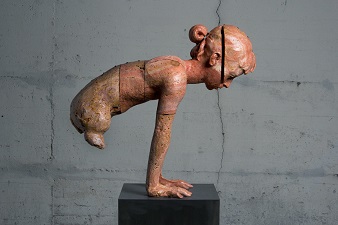Christian Zucconi - sculptor, photographer, videomaker, performer
 Sculpture, photography, video and performance. Every facet of Zucconi’s work is part of a homogenous study of the human body that began with the “kenoclastic” works shown at the Museum of Ancient Art of the Sforzesco Castle in Milan; continued with the “black sculptures” inspired by the underground alleys of the Ancient Hospital of the Ceppo of Pistoia; shifted into the photographic series "Cenere" and "Rewind" and the videos Silence, Blank, Action/Dogma, and climaxed in his latest sculptures inspired by Hobbes’s Leviathan.
In these latest works, Zucconi overturns Michelangelo’s concept of “one block of marble” by using various pieces of “scrap material” pieced together with metal wire and covered with wax: the resulting sculptures symbolize the psychological, sexual, cultural and aesthetic fragmentation of contemporary man; a metaphor of a society that is becoming more and more violent, disintegrated and confused.
Sculpture, photography, video and performance. Every facet of Zucconi’s work is part of a homogenous study of the human body that began with the “kenoclastic” works shown at the Museum of Ancient Art of the Sforzesco Castle in Milan; continued with the “black sculptures” inspired by the underground alleys of the Ancient Hospital of the Ceppo of Pistoia; shifted into the photographic series "Cenere" and "Rewind" and the videos Silence, Blank, Action/Dogma, and climaxed in his latest sculptures inspired by Hobbes’s Leviathan.
In these latest works, Zucconi overturns Michelangelo’s concept of “one block of marble” by using various pieces of “scrap material” pieced together with metal wire and covered with wax: the resulting sculptures symbolize the psychological, sexual, cultural and aesthetic fragmentation of contemporary man; a metaphor of a society that is becoming more and more violent, disintegrated and confused.
Born in 1978 in Piacenza, Zucconi began his artistic research in the 90s, when he visits the quarries in Carrara.
During these years, his focus on technique and his passion for Michelangelo bring about powerful aesthetic creations which are showcased in his first solo exhibition organized by Piero Molinari at the Cattolica University of Piacenza in 1998.
The following ten years see the artist involved in the creation of large public monuments.
The work carried out during these years reaches its peak in the solo exhibition of 2007 and curated by Alain Toubas of the art gallery of the Visconteo Castle in Legnano, where the Huge Sculpture Legione is showcased in Piazza San Magno.
From that moment, Zucconi begins to lose interest in monumental sculpture turning his attention to a more intimate type of sculpting based on his personal interpretation of classical mythology; at the end of 2007 he invents a technique he names “KENOCLASTY” [1]. The results of this «tormented destruction, emptying and reconstruction of statues (and of oneself)» are presented by Rudy Chiappini in 2010 in the “SCANDALOUS” [2] solo exhibit held at the Museum of Ancient Art at the Sforzesco Castle in Milan.
After Oedipus and after Supper in Emmaus were shown at the Venice Biennial in 2011, Zucconi feels his mythological and religious period has come to an end; without further ado he begins to explore the grey areas of contemporary man, from the solo exhibitions at the Civic Museums of Palazzo Farnese in Piacenza curated by Elena Percivaldi and at the Museum of the Cathedral's Work in Prato curated by Luca Beatrice, his sculptures become more and more «brutal and dirty», reaching a climax in 2013 with the “black sculpture period” inspired by the underground alleys of the Ancient Hospital of the Ceppo of Pistoia.
During this rich lapse of time, Zucconi collaborates with Mustafa Sabbagh on common projects involving sculpture and video-installations in Oporto (Portugal) and in Milan on occasion of the exhibit HOT curated by Luca Beatrice; he also plans a three-day happening curated by Antonio Mancinelli called Peep-Hole, which brings to light voyeuristic mechanisms that are usually kept hidden.
Between the end of 2013 and the beginning of 2014, the difficult historical moment and his strong environmental awareness bring Zucconi to overturn michelangelo’s concept of “one block of marble”: by assembling scrap pieces of larger blocks Zucconi begins his so called “leviathan period”; these works are presented to the public for the first time by Emanuele Beluffi in the exhibition Leviathan.
KENOCLASTY [1]
Technique which involves the destruction of a completed work, its emptying and subsequent re-composition.SCANDALOUS [2]
Stella Armando. “Statue osé in mostra, scandalo al Castello”. Corriere della Sera, martedì 9 marzo 2010, p. 1 e 6.Bravi Marta. “I guardiani del Castello: «Questa mostra fa paura ai bambini»” il Giornale, martedì 9 marzo 2010.
Bravi Marta. “«Immagini shock, è un'imboscata: i bambini devono essere preparati»”. il Giornale, mercoledì 11 marzo 2010.
Select an image to enlarge:
Top

























